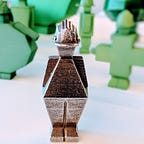Thoughts on Making Onboarding More Human
Along with CBRE Build, many other tech startups are making impressive changes with their new hire onboarding. They’re automating and integrating processes, branding first days with unique swag and experiences, and aligning onboarding with their organizations’ values — all while constantly iterating with feedback and data. In other words, HR and Operations teams who onboard engineers and designers have themselves re- engineered and re- designed the classic onboarding experience. Our Operations team at CBRE Build NYC did all of the above as we revamped our office’s onboarding program. I had the privilege of collaborating with many folks, including our corporate HR and IT teams, hiring managers, and design and engineering leads, to create an experience that quickly brought new hires to productivity while reflecting our organization well.
As someone with a background in acting though, I didn’t want to stop there. I was also interested in the way our onboarding process allowed us to truly connect with our new team members. Beyond finding a sweet spot between process, personalization, branding, etc., the real challenge for me was creating an onboarding program that leveraged the human element. After all, this is human resources (excuse me, ‘people operations’). Despite all the great things we were doing, did our new hires feel open, authentic, and safe during those critical first weeks? How were they feeling?
If this sounds unscientific and woo-woo, it should. Ultimately, good onboarding is preventing that feeling we all had in middle school when we had our lunch tray but no friends to sit with, and great onboarding is eating and laughing and joking, chocolate milk and all. I don’t have business-ready wisdom on human connection, but I do have ongoing, evolving thoughts about the human element in onboarding. Here they are:
1. Make it personal…
I don’t mean have the whole team sign a card on their first day (though definitely customize their experience!). Rather, I suggest HR/Ops teams inject their own experience into the process. During new hire orientation, I openly shared things I personally loved about our culture, things I found interesting or confusing about commercial real estate, even things in which I thought we could improve (careful on this one). This builds trust with your new team members and instantly creates a feeling of authenticity and psychological safety.
2. …but keep the warm and fuzzy in check
With work cultures getting cooler and younger, the pendulum can swing too far the other way, especially with onboarding. It was important for me to remember that
- we represent the business and its goals, and
- there is a diverse set of incoming social and cultural attitudes among new hires, and HR’s job is to accommodate and include them.
In the short term, chumminess is validating, but long term, it can inadvertently create informal structures of exclusion. It’s thus important to introduce your organization in a way that professionalizes your culture, instead of letting the culture make you less professional. In this sense, ‘being human’ means gatekeeping your culture with this inclusive principle.
3. Empower yourself in the group…
Not enough is said about the inferiority complex experienced by HR professionals. The fact that there are several articles out there about the importance of HR, and none about the importance of financial analysts or engineers speaks to this. You can’t empower a new team member if you yourself feel a stratification of importance between your work and the work of those you’re onboarding. Own your work. Spend time improving it, not justifying it. At CBRE, I was privileged to have a leadership team that valued the input of people on the ground floor and empowered them to make structural changes.
4. …so you can empower others.
The pressure was on me to build connections for the new hire. As an introvert, introducing them to each team member and managing conversations was difficult, but it proved essential in terms of jumpstarting their network. The social aspects of onboarding should be active and specific, not passive and general. Scheduling lunches or mentioning a new hire at All Hands is less meaningful than connecting folks on unique extracurricular interests or hobbies, sleuthing around to find shared connections that already exist, etc.
One last note: you’ll notice these ideas apply to the people actually doing the onboarding work on the ground floor. Implementation is everything in employee experience work. If you’re an HR executive reading this, I implore you to listen to your coordinators and receptionists, and create feedback loops that at least pilot their suggestions. Be as curious about their ideas as they are diligent with your strategies. The first day of your next new hire starts with their warm smile at the front door.
Devin Doyle worked on the Operations team of CBRE Build NYC for a year, and recently left for Seattle to earn his MBA at the University of Washington’s Foster School of Business. He hopes to pivot from operations into human capital consulting. He is indebted to the CBRE Build team for allowing him to further develop his interest in all things HR.
